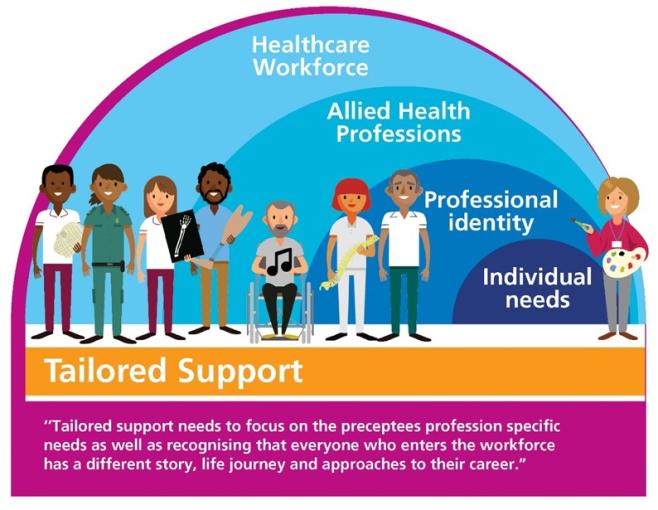You are here
Part One: Background and Context
Introduction and Overview of AHP Preceptorship
Preceptorship can be a powerful workforce interv ention. Starting a new career or experiencing a workplace transition can be both a rewarding and challenging time. Ensuring AHPs have access to support during key transition points in their career is essential for successful professional development.
ention. Starting a new career or experiencing a workplace transition can be both a rewarding and challenging time. Ensuring AHPs have access to support during key transition points in their career is essential for successful professional development.
AHP Preceptorship is a period of structured support provided to AHPs at key moments of career transition. This includes joining the workforce for the first time, returning to work after a long period away (including being re-admitted to the register), working in the UK for the first time, taking up a new role, or moving to a new organisation. Delivered well, it can give AHPs in these situations the confidence to act as an autonomous practitioner.
The purpose of preceptorship is to ensure individuals develop confidence in their abilities and can apply and develop their knowledge in everyday practice. Preceptorship does this by providing a personalised programme of uni-professional and multi-professional development opportunities with support from an experienced professional. To be most effective it is important that preceptorship is a tailored intervention, meeting each individual’s needs. This tailored approach should build on their personal journey into their profession, reference their experience and consider their personal career development.
Preceptorship is not workplace induction, probation, or a substitute for mandatory training. It is distinct from clinical supervision and performance management. It is a supportive intervention to ensure that individuals’ workforce transitions are successful for both individuals and the organisations in which they work.
The positive impacts of preceptorship are evident across the workforce for:
- the individual (i.e., improving their confidence)
- the organisation (i.e., improving employer ability to recruit and retain staff, ensuring a culture of patient safety)
- the system (i.e., workforce sustainability)
Who are AHPs?
AHPs form the third largest clinical workforce in the National Health Service (NHS). AHPs are professionally autonomous practitioners educated to at least degree level. They comprise of fourteen distinct occupations:
- Art therapists
- Dietitians
- Drama-therapists
- Music therapists
- Occupational therapists
- Operating department practitioners
- Orthoptists
- Osteopaths
- Paramedics
- Physiotherapists
- Podiatrists
- Prosthetists and orthotists
- Diagnostic and therapeutic radiographers
- Speech and language therapists
AHPs provide system-wide care. AHPs assess, treat, diagnose, and discharge patients across health, social care, housing, education, early years, schools, the criminal justice system, independent and voluntary sectors.